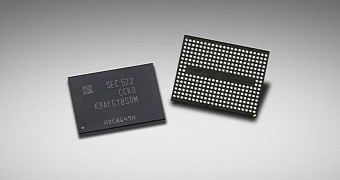Samsung has recently announced that it has started producing the world's first triple-level-cell (TLC) three-dimensional vertical NAND flash chips with 256Gb capacity, and the company believes that the new 3D V-NANDs will allow it to make more affordable flash-based devices.
The South Korean company explains that the new 256Gb TLC NAND flash memory will use the same 3D Charge Trap Flash technology where 48 cells are being stacked through some 1.8 billion channel holes that will punch through the arrays, all made possible by a new etching technology. Overall, each chip will contain over 85.3 billion cells and will be able to store around 32GB of data.
According to Samsung, the new 48-layer 256Gb TLC NAND flash chip will be 30 per cent more eco-friendly than its predecessor, which had 128Gb capacity, while also being 40% smaller, something that will significantly reduce costs.
Samsung will offer bigger, better and cheaper memory chips
Samsung has high hopes that its 3rd generation V-NAND memory will help it increase its market share. The improved performance and smaller chips will most likely increase the company's revenue and will accelerate the growth of the high-performance and high-density SSD markets. Samsung also hopes that, with this new technology, it will expand its premium-level business in the enterprise data center market segments, as well as the consumer market.
This basically means cheaper 1TB and 2TB SSDs for consumers, a very welcoming thing for casual clients, while much faster enterprise SSDs will be available very soon.
However, looking at things from a general perspective, it's worth mentioning that right now Samsung's main competitor in this field is none other than Toshiba, which is also working on NAND stacked memory chips that will store 64GB of data.
Doubling that amount of storage space, Toshiba hopes that with its new 16-die stacked NAND flash packages, future SSDs will break the 10TB barrier and will reach storage sizes of 16TB, much more than what current HDDs can offer.

 14 DAY TRIAL //
14 DAY TRIAL //